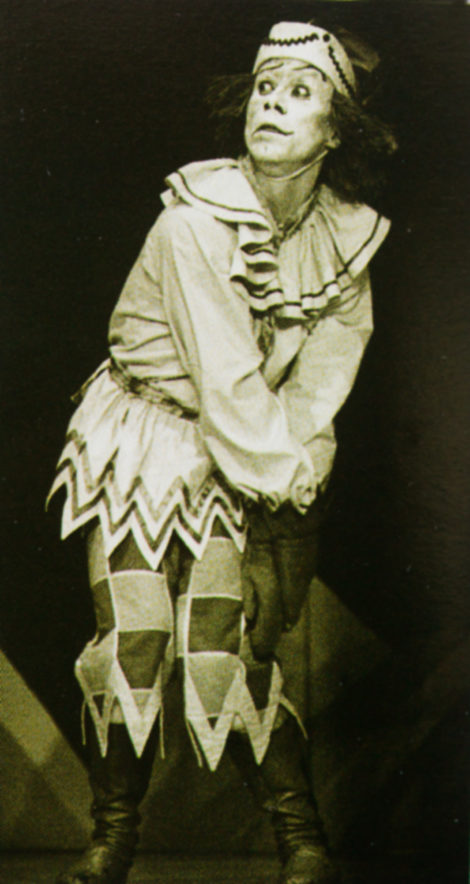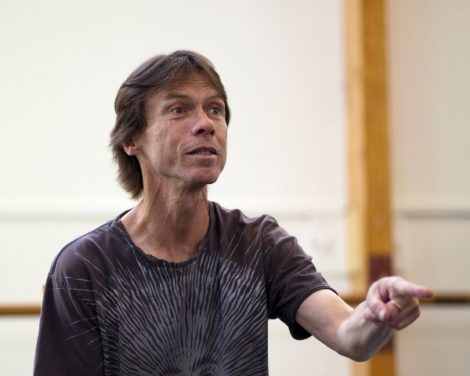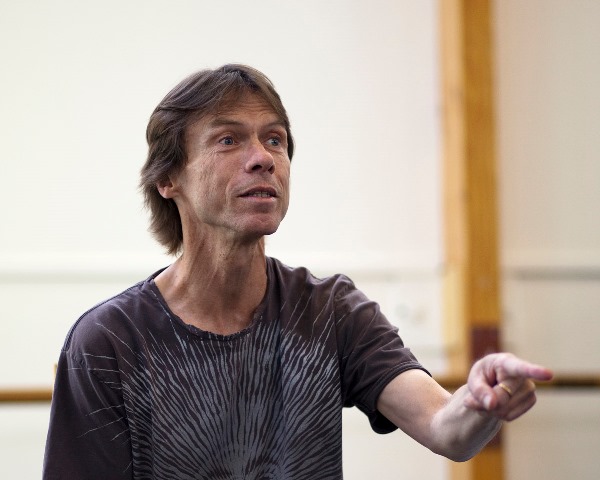Douglas James Wright, dreamer of dances
by Jennifer Shennan
Douglas Wright, dancer, choreographer, writer, poet, visual artist, has died at the age of 62.
An obituary is normally about the deceased, but I begin with my declaration of conflict of interest (actually, deeply shared interest)—namely, that Douglas is the single most important artist in my life. His fearless vision through an astonishingly prolific artistic output moved us beyond comfort, beyond normalcy, beyond the already known. Not fantasy, not surrealism, not escapism, but expressionist art of the highest order, framed with wit—dark, caustic, incorrigible, ironic and hilarious by turns, and teeming with alternative perceptions of the natural and social givens. As a New Zealand artist across five genres, Douglas Wright remains a phenomenon without peer.
The Solomon Islands term for a choreographer translates as ‘dreamer of dances’. That epithet pleased Douglas since he often referenced Morpheus, god of dreams, son of Hypnos, god of sleep. His last dance, commissioned by art gallery director Michael Lett, was exquisitely performed by Sean MacDonald at Tempo Dance Festival in October, with final rehearsals conducted at the hospice. Titled M_Nod, with Morpheus in mind, it incorporated a James Joyce reading from Finnegan’s Wake, an aesthetic that suited Douglas well. The work was dedicated to the late Sue Paterson, Douglas’ long-standing colleague and friend.
In 1998 Douglas was made a Member of the New Zealand Order of Merit, and in 2000 a Laureate of The Arts Foundation. His company, Douglas Wright and Dancers, only ever received project-based funding from the Arts Council and there can be no easy way to analyse why his phenomenal talent was not better supported and continuously facilitated across the decades. Permanent funding of company management and adequate resources to tour his work internationally were what he wanted and deserved, but they were never forthcoming. In that, we let down both him and ourselves.
Now that Douglas is safely silenced, the tributes are flowing in torrents. Our best honour to him however is to remember his work, and lucky we are that he has written about dance, the most ephemeral of the arts, in depth and detail. The outstanding video documentary Haunting Douglas by Leanne Pooley (Spacific Films) is the finest portrait of a dance artist anywhere.
A consummate man of the theatre, the words Douglas loathed most were ‘bland’ and ‘boring’. His constant attention was to our experiences—the public, the personal and the private. If it had happened, or been thought or dreamt, then spit it out, say it loud, choreograph it, write it, draw it, sculpt it, tell it as it is. If some audiences or critics took offence, at least they were not bored. It was proof they were engaged. An indelible image remains—from Black Milk—when Three Graces, dressed in nurses’ uniforms, brought forward a tray of medical syringes then knelt to inject the stage floor, presumably a local anaesthetic to help us through what was to follow.
Douglas certainly had a gift for naming his dances—listen to them—Now is the Hour, Passion Play, How on Earth, As It Is, Buried Venus, Inland, Forever, Black Milk, Rapt, The Kiss Inside. He did not need tertiary education to lead him to literature, but as a school boy simply raided the library. His voracious reading habits included an early affinity with the writings of Janet Frame. His memoir, Ghost Dance, (Penguin, 2004, awarded the Montana prize for Best First Book) makes clear the abiding importance of his relationship with artist Malcolm Ross. (David Eggleton’s 2004 review for The Listener of Ghost Dance is definitive).
Douglas grew up in rural New Zealand, in Tuakau. The place name means tu = to stand, akau = river bank. You get a good view of a river when you stand on its bank. You get a good view of Douglas Wright through Pooley’s documentary, about his childhood intrigue at the woman dancing in a white dress on the porch of the neighbouring house in moonlight (‘…perhaps she was a moth who laid her eggs in me’) and fascination with his grandmother taking him to Catholic Mass (later referenced in Halo, for Royal New Zealand Ballet).
To his father’s disgust, rugby held no interest for the child but Douglas’ childhood talent for gymnastics brought him junior champion status and photos reveal a strength, grace and line that would eventually lead him to dance. The boy travelled alone from Tuakau to Auckland for regular training sessions, which led into the darkness of predatory sexual abuse in bus stations as bad as anything you’ve imagined. He was robbed of his childhood and the scars lasted for life, yet he could later communicate the complexity of the experiences without letting it destroy him. One poem, in his volume CactusFear (Steele Roberts, 2011) tells us about it, if you can get through it without crying.
After leaving school there was a dramatic drug career, eventually supplanted by his dance career, initially with Auckland-based Limbs Dance Company (1980–1983). Teacher Dorothea Ashbridge imparted the ballet technique that helped Douglas ‘map my body … give names and directions to movements my body already knew’. He spent 1983–1987 with Paul Taylor Dance Company in New York, a spectacular career, with performances and choreography (Hey Paris, Faun Variations) still remembered decades later by New Yorkers who probably see six dance performances every week.
Douglas’ astonishing strength combined with lyricism can be seen in DV8’s talisman and horrifyingly brilliant work by Lloyd Newson, Dead Dreams of Monochrome Men, in 1988 (available on dvd). Back in New Zealand Douglas’ grief at losing friends to Aids is choreographed into Elegy, 1992. Although not the death sentence it once signaled, Douglas’ own HIV diagnosis was encompassed in choreographies Forever and Ore.
In 1993 Russell Kerr cast Douglas in the title role of his production of Petrouchka for Royal New Zealand Ballet, described in Royal New Zealand Ballet at Sixty (VUP, 2013). His insights into performing that celebrated role, created by Nijinsky, are rare, if not unique, in the annals of ballet history. Douglas wrote what Nijinksy was unable to.

Three works commissioned by Royal New Zealand Ballet, The Decay of Lying (1992), Rose and Fell, (1997) and Halo (2000) are all remembered by the dancers. Critics were challenged, as critics often are, but Douglas remained disappointed that the company never re-staged any of those works.
Douglas’ mercurial and multi-faceted personality was reflected in his works—by turns ecstatic (Gloria, A Far Cry); melancholic (Terra Incognito, Black Milk); grief-stricken (Elegy, Rose & Fell); satirical (The Decay of Lying); gender-shifting (Hey Paris, Forever); political (Black Milk); spiritual (Rapt, The Kiss Inside). We sense that whatever happened to him surfaced somewhere in one of his choreographies, but were never just about himself. He staged themes that may have shocked, or saddened, but they rang with truth.
Douglas released the artistry in many dancers and they know who they are. Lisa Densem (in the astonishing photo montage by Peter Molloy on the cover of the Pooley documentary) told me, ‘After you’ve worked with Douglas you have had more than a dance experience. He lets you become his friend.’
Several dancers became his muses: Debbie McCulloch with whom he shared an early close rapport; the enigmatic ‘goddess-like’ Kilda Northcott; Sarah Jayne Howard, a fiery furnace of a performer. Alex Leonhartsberger danced like Douglas-come-again, then Sean MacDonald became the final trusted courier of Douglas’ dream visions. Repertoire has been expertly staged in recent years by rehearsal director, Megan Adams.
There were only the briefest tours taking Douglas’ works abroad, yet, had that been responsibly managed and financed, he would have earned an international reputation as the Pina Bausch of the Southern Hemisphere. Nought to be done about that now but live with it. At least his treasures are in Nga Taonga Film & Sound Archive, in art galleries, on bookshelves, and in the Alexander Turnbull Library.
Douglas once asked me how baroque dance works—not that he wanted to perform one, just to understand how people danced in different times and places, so I showed him. He instantly caught the implications of the highly stylised technique, then quoted Louis XIV to me, and in one hour learned a sarabande that would take a ‘normal’ student a year to master.
Five of Douglas’ drawings, purchased by the Chartwell Collection for Auckland Art Gallery, hang in a current exhibition there alongside works by Colin McCahon, by Gretchen Albrecht (who provided the backdrop for Douglas’ first full-length work, Now is the Hour) and Jim Allen, celebrated sculptor of light. Douglas’ note alongside his work reads, ‘The figures in my drawings are verbs not nouns’. A number of these drawings are incorporated into his volume of poetry, Laughing Mirror, (Steele Roberts, 2007) where he famously penned the line, ‘Never trust an artist who is always trying to explain their work’.
Perhaps Auckland City Council might consider converting Douglas’ council flat, his home for many decades, in Norgrove Ave, Mt. Albert, into a choreographic residence? Alongside all else, Douglas was a perfectionist, not to say obsessive, gardener. The ancient cycads growing there (he would groom the spider webs off them with a toothbrush) might inspire a younger generation of home-grown dance-makers. Goodness knows, the country needs them.
Helen Aldridge, a Waiheke teacher and arts advocate, commissioned from Douglas a choreography to commemorate the life of her daughter, Deirdre Mummery, who died of an accidental drug overdose. Helen told me she did not know what to expect—perhaps a lament, or lachrimae? Instead, Douglas produced the exquisite Gloria, to Vivaldi, celebrating the life of his young friend. Gold silk-clad dancers fly and twist and turn in an airborne wonder. It’s the best dance ever made, by anyone, anywhere.
Beautifully filmed by Alun Bollinger, it’s there on YouTube (note, inexplicably, in two parts), posted anonymously by ‘a Rugby supporter’. Where is James Joyce when you need him?
Douglas is survived by his loyal and devoted mother, Pat, and the dancers of New Zealand.
Douglas James Wright: born 14 October 1956, Pukekohe; died 14 November 2018, Auckland
Acknowledgements: Megan Adams, Helen Aldridge, Lisa Densem, Sarah (Lawrey) George, Sean MacDonald, Keith McEwing, Leanne Pooley, Turid Revfeim, Guy Robinson, Anne Rowse, Roger Steele
This obituary is posted with the permission of The Dominion Post where it appeared on 17 November 2018.
Featured image: Douglas Wright, 2006. Photo: © John Savage

For other posts on this website about Douglas Wright, including reviews about some of the works mentioned above, follow this tag link.

One thought on “Douglas Wright (1956–2018)”